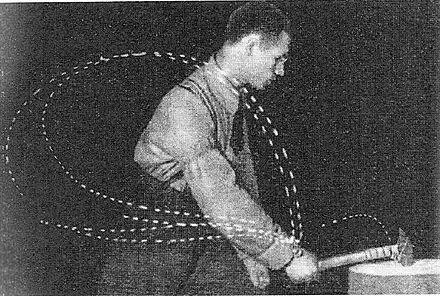In the 1920s, Nikolai Bernstein, a mostly self-taught neurophysiologist and pioneer in the field of motor control, studied the movements of blacksmiths at Moscow’s Central Institute of Labor. Bernstein used cyclographic photography techniques to track the motions used to cut metal with a chisel and hammer. (See photo above.) His research showed how repeating movements comprise a series of smaller movements. It also showed the importance of variability in blacksmiths’ arm movements. It turns out that the most accurate blacksmiths showed the most variability in their motor patterns. The best blacksmiths found many ever-changing ways to consistently arrive at the same hitting spot.
Bernstein’s research came to the attention of the wider world with the publication of his 1967 book, The co-ordination and regulation of movements (Oxford : Pergamon Press), a collection of writings on motor control. This book is the source of a now famous quote about practicing: practice is a particular type of repetition without repetition. For Bernstein, practice is a way of solving problems not by doing the same thing over and over, but by subtly varying one’s strategies from repetition to repetition—much like the accurate blacksmith whose arm/hammer movements are different each time around.
Here is the passage from The co-ordination and regulation of movements where Bernstein applies lessons from his research on motor habits to understanding what it means to practice:
“The process of practice towards the achievement of new motor habits essentially consists in the gradual success of a search for optimal motor solutions to the appropriate problems. Because of this, practice, when properly undertaken, does not consist in repeating the means of solution of a motor problem time after time, but in the process of solving this problem again and again by techniques which we changed and perfected from repetition to repetition. It is already apparent here that, in many cases, ‘practice is a particular type of repetition without repetition’ and that motor training, if this position is ignored, is merely mechanical repetition by rote, a method which has been discredited in pedagogy for some time” (p. 134).
•
Bernstein’s ideas on motor habits have been adopted in movement science and sports training, but they are also useful far beyond these realms. For example, I’ve been thinking about them in the context of music and how composing/producing is repeatedly solving recurring problems of form and feeling using ever-varied and evolving techniques. Building on Bernstein, we can frame composing not as a mechanical repetition of learned techniques that have worked on previous projects, but rather a fluid practice of innovating novel ways of making compelling sounds. Bernstein’s emphasis on the process of solving the same problem over and over, yet in different ways points us to a holistic view of creativity as the ability to adapt to ever-changing aesthetic situations (e.g. this sound, these chords, this tempo, my limits of patience, etc.) to reliably produce a desired, if unpredictable, outcome.
In my own practice—a practice I practiced before encountering Bernstein’s repetition without repetition concept—I constantly vary the way I work. Each piece comes together differently. I don’t re-use sounds, samples, or effects without varying them. When I encounter a familiar sound, I make a change to it and save it—ostensibly for later use, but really just to register to myself that I’ve made a change to initiate something new. Making small changes allows me to repeat without repeating.
Even as each track comes together differently, I try to use whatever I happen upon in the moment as the basis for an entire piece. This doesn’t always work, but it’s more likely to work when I commit to the idea. What I’ve happened upon can be anything. If I’ve improvised a 37-bar sequence of chords, that will do. If I’ve made a strange-sounding effect, I work with that. If I’ve tweaked a set of drum sounds, I start with those. Such creative constraints provide something analogous to the blacksmith’s hitting spot, focusing my attention on practicing novel solutions to that recurring challenge: How do I make music that sounds good?



Leave a comment